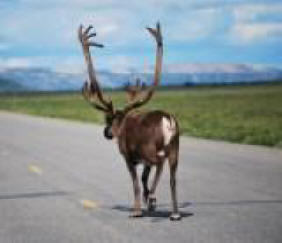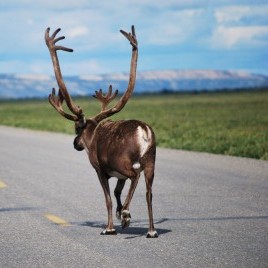The moose became the official Alaska land mammal May 1, 1998, under Governor Tony Knowles . Moose can be found from the Unuk River in Southeast to the Arctic Slope, but are most abundant in second-growth birch forests, on timberline plateaus and along major rivers of Southcentral and Interior. They are not found on islands in Prince William Sound or the Bering *Sea, on most major islands in Southeast, on Kodiak, or the Aleutians groups." Moose live from the Stikine River in the Panhandle to the Colville River on the Arctic Slope.
The moose is the largest extant species in the deer family. Moose are distinguished by the palmate antlers of the males; other members of the family have antlers with a dendritic ("twig-like") configuration. Moose typically inhabit boreal and mixed deciduous forests of the Northern Hemisphere in temperate to subarctic climates. Moose used to have a much wider range but hunting and other human activities greatly reduced it over the years. Moose have been re-introduced to some of their former habitats.
Moose diet consists of both terrestrial and aquatic vegetation. The most common moose predators are wolves, bears, and humans. Unlike most other deer species, moose are solitary animals and do not form herds. Although generally slow-moving and sedentary, moose can become aggressive and move surprisingly fast if angered or startled. Their mating season in the autumn can lead to spectacular fights between males competing for the right to mate with a particular female.
Cow moose generally breed at 28 months, though some may breed as young as 16 months. Calves are born any time from mid- May to early June after a gestation period of about 230 days. Cows give birth to twins 15 to 75 percent of the time, and triplets may occur once in every 1,000 births. The incidence of twinning is directly related to range conditions. A cow moose defends her newborn calf vigorously. Calves begin taking solid food a few days after birth. They are weaned in the fall at the time the mother is breeding again. The maternal bond is generally maintained until calves are 12 months old at which time the mother aggressively chases her offspring from the immediate area just before she gives birth.
Moose breed in the fall with the peak of the "rut" activities coming in late September and early October. Adult males joust during the rut by bringing their antlers together and pushing. Serious battles are rare. Bulls may receive a few punctures or other damage and occasionally die from their wounds. The winner usually mates with the female. By late October, adult males have exhausted their summer accumulation of fat and their desire for female company. Once again they begin feeding. Antlers are shed as early as November, but mostly in December and January.
Newborn calves weigh 28 to 35 pounds and within five months grow to over 300 pounds. Males in prime condition weigh from 1,200 to 1,600 pounds. Adult females weigh 800 to 1,300 pounds. Only the bulls have antlers. The largest moose antlers in North America come from Alaska, the Yukon Territory, and the Northwest Territories of Canada. Trophy class bulls are found throughout Alaska, but the largest come from the western portion of the state. Moose occasionally produce trophy-size antlers when they are 6 or 7 years old, with the largest antlers grown at approximately 10 to 12 years of age. In the wild, moose rarely live more than 16 years.
Moose lack upper front teeth, but have eight sharp incisors on the lower jaw. They also have a tough tongue, lips and gums, which aid in the eating of woody vegetation. Moose have six pairs of molars and, ahead of those, six pairs of premolars, to grind up their food. A moose's diet often depends on its location, but they seem to prefer the new growths from trees such as white birch, trembling aspen and striped maple, among many others. Many aquatic plants include lilies and pondweed. Moose are excellent swimmers and are known to wade into water to eat aquatic plants. In non polar regions this trait serves a second purpose in cooling down the moose on summer days and ridding itself of black flies. Moose are thus attracted to marshes and river banks during warmer months as both provide suitable vegetation to eat and water to wet themselves in.
Because moose range over so much of Alaska, they have played an important role in the development of the state. At one time professional hunters supplied moose meat to mining camps. Historically, moose were an important source of food, clothing, and implements to
Athabaskan Indians dwelling along the major rivers. Today, Alaskans and nonresidents annually harvest approximately 6,000 to 8,000 moose, some 3.5 million pounds of meat. Moose are an important part of the Alaskan landscape, and tourists photograph those animals that feed along the highway.
|








